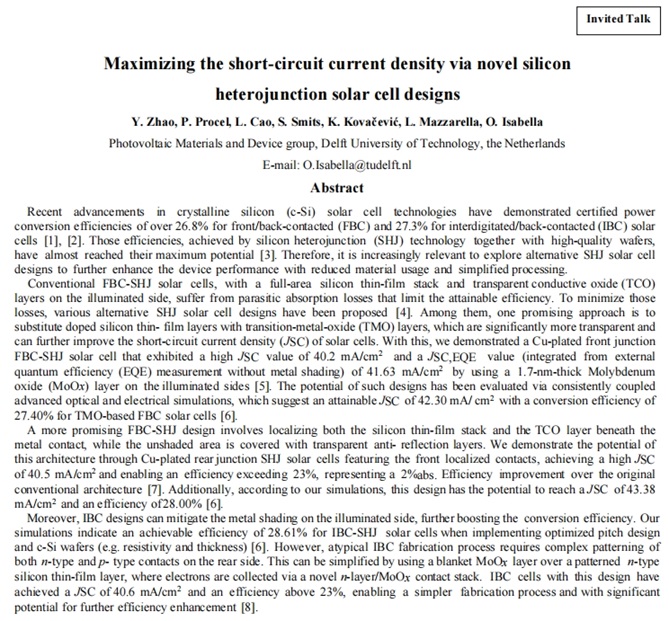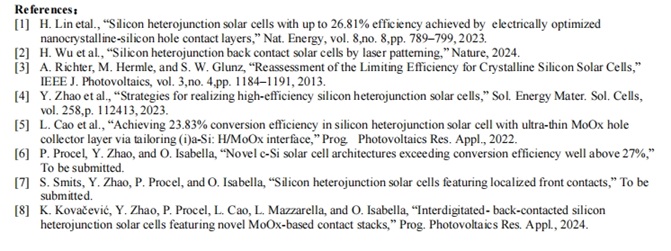| Maximizing the short-circuit current density via novel silicon heterojunction solar cell designs【Olindo Isabella】 |
| 发布时间:2024-10-23 | 浏览次数:291 |
Maximizing the short-circuit current density via novel silicon heterojunction solar cell designs Y. Zhao, P. Procel, L. Cao, S. Smits, K. Kovačević, L. Mazzarella, O. Isabella Photovoltaic Materials and Device group, Delft University of Technology, the Netherlands E-mail: O.Isabella@tudelft.nl Abstract Recent advancements in crystalline silicon (c-Si) solar cell technologies have demonstrated certified power conversion efficiencies of over 26.8% for front/back-contacted (FBC) and 27.3% for interdigitated/back-contacted (IBC) solar cells [1], [2]. Those efficiencies, achieved by silicon heterojunction (SHJ) technology together with high-quality wafers, have almost reached their maximum potential [3]. Therefore, it is increasingly relevant to explore alternative SHJ solar cell designs to further enhance the device performance with reduced material usage and simplified processing. Conventional FBC-SHJ solar cells, with a full-area silicon thin-film stack and transparent conductive oxide (TCO) layers on the illuminated side, suffer from parasitic absorption losses that limit the attainable efficiency. To minimize those losses, various alternative SHJ solar cell designs have been proposed [4]. Among them, one promising approach is to substitute doped silicon thin- film layers with transition-metal-oxide (TMO) layers, which are significantly more transparent and can further improve the short-circuit current density (JSC) of solar cells. With this, we demonstrated a Cu-plated front junction FBC-SHJ solar cell that exhibited a high JSC value of 40.2 mA/cm2 and a JSC,EQE value (integrated from external quantum efficiency (EQE) measurement without metal shading) of 41.63 mA/cm2 by using a 1.7-nm-thick Molybdenum oxide (MoOx) layer on the illuminated sides [5]. The potential of such designs has been evaluated via consistently coupled advanced optical and electrical simulations, which suggest an attainable JSC of 42.30 mA/cm2 with a conversion efficiency of 27.40% for TMO-based FBC solar cells [6]. A more promising FBC-SHJ design involves localizing both the silicon thin-film stack and the TCO layer beneath the metal contact, while the unshaded area is covered with transparent anti- reflection layers. We demonstrate the potential of this architecture through Cu-plated rear junction SHJ solar cells featuring the front localized contacts, achieving a high JSC of 40.5 mA/cm2 and enabling an efficiency exceeding 23%, representing a 2%abs. Efficiency improvement over the original conventional architecture [7]. Additionally, according to our simulations, this design has the potential to reach a JSC of 43.38 mA/cm2 and an efficiency of 28.00% [6]. Moreover, IBC designs can mitigate the metal shading on the illuminated side, further boosting the conversion efficiency. Our simulations indicate an achievable efficiency of 28.61% for IBC-SHJ solar cells when implementing optimized pitch design and c-Si wafers (e.g. resistivity and thickness) [6]. However, atypical IBC fabrication process requires complex patterning of both n-type and p- type contacts on the rear side. This can be simplified by using a blanket MoOx layer over a patterned n-type silicon thin-film layer, where electrons are collected via a novel n-layer/MoOx contact stack. IBC cells with this design have achieved a JSC of 40.6 mA/cm2 and an efficiency above 23%, enabling a simpler fabrication process and with significant potential for further efficiency enhancement [8]. References:
|







